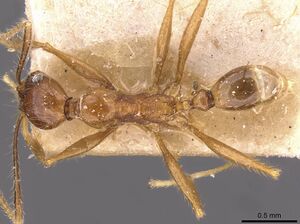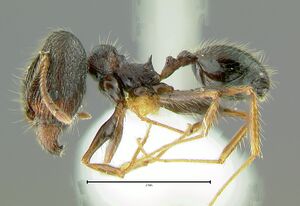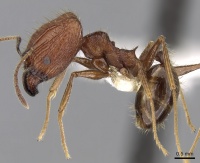Pheidole aglae
| Pheidole aglae | |
|---|---|

| |
| Scientific classification | |
| Kingdom: | Animalia |
| Phylum: | Arthropoda |
| Class: | Insecta |
| Order: | Hymenoptera |
| Family: | Formicidae |
| Subfamily: | Myrmicinae |
| Tribe: | Attini |
| Genus: | Pheidole |
| Species: | P. aglae |
| Binomial name | |
| Pheidole aglae Forel, 1913 | |
| Synonyms | |
| |
This species inhabits well-developed forests (including primary and well-recovered secondary forests) from lowlands to hill areas. It nests in rotting wood blocks and logs on the forest floor. I have never encountered colonies which include more than one dealate queen. (Eguchi 2001a) Heterick & Kitching (2022) collected this species in a pitfall trap within a lowland dipterocarp forest in Brunei.
| At a Glance | • Ergatoid queen |
Identification
Eguchi (2001a) - This relatively large-sized species, with 3-segmented antennal club, is recognisable among Indo-Malayan congeners by having minor's head with occipital carina forming a well-developed flange. The most similar species is the sympatric Pheidole cariniceps, but in the latter antennal scrobe of the major is margined below by a marked carina; propodeal spine of the major has broad base; prominence on posterior declivity of promesonotum, and dorsum of propodeum bears a pair of standing hairs in the minor. I could examine one syntype (minor) of Pheidole longicornis. Morphological similarity between the minor of P. aglae and that of P. longicornis strongly suggests their conspecificity. However, I could not confirm it, since major(s) which should be included in the type material of P. longicornis according to Emery's original description could not be examined.
Majors from Poring and Sayap Kinabalu have, in general, a deeper emargination on posterior margin of head than those from other localities in Borneo, although intermediate conditions occur when we observe all the available Bornean specimens.
Keys including this Species
- Key to Pheidole majors and minors of Borneo
- Key to Pheidole majors of Borneo
- Key to Pheidole minors of Borneo
Distribution
Latitudinal Distribution Pattern
Latitudinal Range: 6.733167° to -7.720278°.
| North Temperate |
North Subtropical |
Tropical | South Subtropical |
South Temperate |
- Source: AntMaps
Distribution based on Regional Taxon Lists
Indo-Australian Region: Borneo, Brunei Darussalam, Indonesia (type locality), Malaysia, New Guinea, Philippines, Singapore.
Oriental Region: Thailand.
Distribution based on AntMaps
Distribution based on AntWeb specimens
Check data from AntWeb
Countries Occupied
| Number of countries occupied by this species based on AntWiki Regional Taxon Lists. In general, fewer countries occupied indicates a narrower range, while more countries indicates a more widespread species. |

|
Estimated Abundance
| Relative abundance based on number of AntMaps records per species (this species within the purple bar). Fewer records (to the left) indicates a less abundant/encountered species while more records (to the right) indicates more abundant/encountered species. |

|
Biology
Castes
Worker
Minor
Images from AntWeb
   
| |
| Worker. Specimen code casent0281669. Photographer Estella Ortega, uploaded by California Academy of Sciences. | Owned by NHMUK, London, UK. |
   
| |
| Syntype of Pheidole aglae. Worker. Specimen code casent0904253. Photographer Z. Lieberman, uploaded by California Academy of Sciences. | Owned by MSNG, Genoa, Italy. |
   
| |
| Paralectotype of Pheidole aglae. Worker. Specimen code casent0907857. Photographer Will Ericson, uploaded by California Academy of Sciences. | Owned by MHNG, Geneva, Switzerland. |
   
| |
| Syntype of Pheidole exasperata fusiformis. Worker. Specimen code casent0907876. Photographer Will Ericson, uploaded by California Academy of Sciences. | Owned by MHNG, Geneva, Switzerland. |
Major
Images from AntWeb
   
| |
| Lectotype of Pheidole aglae. Worker (major/soldier). Specimen code casent0907856. Photographer Will Ericson, uploaded by California Academy of Sciences. | Owned by MHNG, Geneva, Switzerland. |
   
| |
| . | |
   
| |
| Syntype of Pheidole exasperata fusiformis. Worker (major/soldier). Specimen code casent0907875. Photographer Will Ericson, uploaded by California Academy of Sciences. | Owned by MHNG, Geneva, Switzerland. |
Nomenclature
The following information is derived from Barry Bolton's Online Catalogue of the Ants of the World.
- aglae. Pheidole aglae Forel, 1913k: 32 (s.w.q.) INDONESIA (Java). Senior synonym of concordia, fusiformis: Eguchi, 2001a: 3. See also: Eguchi, 2001b: 27.
- fusiformis. Pheidole exasperata var. fusiformis Viehmeyer, 1914d: 607 (s.w.m.) NEW GUINEA. Junior synonym of aglae: Eguchi, 2001a: 3.
- polita. Pheidole exasperata var. polita Viehmeyer, 1914d: 606 (s.w.) SINGAPORE. [Junior primary homonym of polita Emery, above.] Replacement name: concordia Santschi, 1916d: 242.
- concordia. Pheidole exasperata var. concordia Santschi, 1916d: 242. Relacement name for polita Viehmeyer, 1914d: 606. [Junior primary homonym of polita Emery, 1894c: 155.] Junior synonym of aglae: Eguchi, 2001a: 3.
Unless otherwise noted the text for the remainder of this section is reported from the publication that includes the original description.
Description
Worker
Eguchi (2001a) - Major Measurements and indices (n=10): TL 3.5-4.6 mm, HL 1.51-1.98 mm, HW 1.33-1.71 mm, SL 1.08-1.17 mm, FL 1.47-1.60 mm, CI81-88, SI68-81, FI 94-113. Head broadest at 1/2-5/8 distance of head (as measured from the mid-point of a transverse line spanning the anteriormost and posteriormost projecting points, respectively (Fig. 4A), in profile weakly or hardly impressed on vertex (Fig. 4C). Hypostoma bearing three low median processes. Clypeus rarely with a median longitudinal carina, with anterior margin emarginate medially. Eye situated at about 1/3 distance of head; distance between mandibular insertion and anterior margin of eye 1.4-1.8 times as long as maximal diameter of eye. Frontal carina distinct, extending backward to 7/10-3/4 distance of head (Fig. 4A). Antennal scrobe very weak, running along frontal carina. Antenna with 3-segmented club; scape extending backward to about 3/4 distance of head; terminal segment ca. 0.8 times as long as preceding two segments together. Masticatory margin of mandible with apical and preapical teeth, and a denticle in front of basal angle. Promesonotal dome with a distinct prominence on its posterior declivity (Fig. 40); the prominence in anterior view not concave medially. Mesopleuron with an inconspicuous transverse impression, or without impression. Propodeal spine horn-like, straight or slightly curved, with narrow base, 3.5-4 times as long as diameter of propodeal spiracle. Petiole in profile cuneiform, 1.2-1.4 times as long as postpetiole (excluding helcium); petiolar node in posterior view not or very weakly emarginate at apex. Postpetiole in dorsal view subpentagonal, 2.1-2.5 times as broad as petiolar node.
Frons to vertex longitudinally rugose; dorsal and lateral faces of occipital lobe reticulate; promesonotum in dorsal view transversely rugose, with smooth and shining interspaces; mesopleuron and lateral face of propodeum weakly rugoso-reticulate, with punctured enclosures; lateral face of petiole weakly punctured; dorsum of petiole smooth and shining; postpetiole and anterior part of first gastral tergite usually weakly or very weakly punctured. Outer face of mandible covered with relatively long decumbent hairs, which are 0.08-0.10 mm in length and almost as long as distance between piligerous punctures. Body brown, reddish-brown or dark reddish-brown, with a little darker abdomen; flagella and tarsi lighter than alitrunk.
Minor Measurements and indices (n=10): TL 2.7-3.0 mm, HL 0.77-0.91 mm, HW 0.55-0.65 mm, SL 1.07-1.30 mm, AL 1.14-1.33 mm, FL 1.18-1.45 mm, CI 69-73, SI 187-202, FI 209-225. Head in full-face view oval; occipital carina forming a well-developed flange (Fig. 4E, F). Clypeus without a median longitudinal carina (or rarely with inconspicuous carina), with anterior margin in full-face view truncate medially. Eyes situated just in front of midlength of head; distance between mandibular insertion and anterior margin of eye 0.9-1.0 times as long as maximal diameter of eye. Frontal carina and antennal scrobe present only around antennal insertion. Antenna with 3-segmented club; in full-face view scape extending beyond posterior border of head by more than its 1/3 length; terminal segment 0.7-0.8 times as long as preceding two segments together. Promesonotal dome with a low prominence on its posterior declivity (Fig. 4G). Mesopleuron without a transverse impression. Propodeal spine elongate-triangular, 1.5-2.5 times as long as diameter of propodeal spiracle. Petiole in profile cuneiform, 1.2-1.3 times as long as postpetiole (excluding helcium); petiolar node low, in posterior view not emarginate at apex. Postpetiole in dorsal view subpentagonal, ca. 2.0 times as broad as petiolar node.
Area between antennal insertion and eye weakly punctured; c1ypeus smooth and shining, or very weakly punctured; remainder of head smooth and shining (rarely punctured weakly); promesonotal dome smooth and shining, or concentrically puncto-rugose in dorsal view; remainder of alitrunk punctured; lateral face of petiole punctured; dorsum of petiole, and postpetiole and gaster almost smooth and shining. Prominence on posterior declivity of promesonotum, and dorsum of propodeum in profile each bearing at least two pairs of standing hairs. Body colour pattern similar to that of the major.
Type Material
Eguchi (2001b) - major, minor and queen; Bogor, Java. Five syntypes (2 majors and 3 minors, Musee d'Histoire Naturelle Genève) were examined, of which one major is designated as the lectotype.
References
- Eguchi, K. 2001a. A revision of the Bornean species of the ant genus Pheidole (Insecta: Hymenoptera: Formicidae: Myrmicinae). Tropics Monograph Series. 2:1-154.
- Eguchi, K. 2001b. A taxonomic study on Asian Pheidole (Hymenoptera, Formicidae): new synonymy, rank changes, lectotype designations and redescriptions. Insecta Koreana. 18:1-35.
- Eguchi, K. 2003. A Study on the Male Genitalia of Some Asian Species of Pheidole (Hymenoptera, Formicidae, Myrmicinae). Sociobiology 41(2): 317-355 (page 319, fig.2 male genitalia described)
- Forel, A. 1913l. Wissenschaftliche Ergebnisse einer Forschungsreise nach Ostindien ausgeführt im Auftrage der Kgl. Preuss. Akademie der Wissenschaften zu Berlin von H. v. Buttel-Reepen. II. Ameisen aus Sumatra, Java, Malacca und Ceylon. Gesammelt von Herrn Prof. Dr. v. Zool. Jahrb. Abt. Syst. Geogr. Biol. Tiere 36: 1-148 (page 32, soldier, worker, queen described)
- General, D.E.M. 2021. A preliminary checklist of the ants (Hymenoptera: Formicidae) of the Mt. Pantaron Range, Bukidnon Province, Mindanao Island, Philippines. Halteres, 12:4-14 (doi:10.5281/ZENODO.5371745).
- General, D.E.M., Buenavente, P.A.C., Peeters, C. 2020. The twists and turns of biological research: first record of an ergatoid queen in the ant genus Pheidole Westwood, 1839, and implications for dispersal and life history. Asian Myrmecology 13: e013002 (doi:10.20362/am.013002).
- General, D.E.M., Buenavente, P.A.C., Rodriguez, L.J.V. 2020. A preliminary survey of nocturnal ants, with novel modifications for collecting nocturnal arboreal ants. Halteres 11: 1-12 (doi:10.5281/ZENODO.3707151).
- Heterick, B.E., Kitching, R.L. 2022. The ants (Hymenoptera: Formicidae) of a one-hectare plot of lowland dipterocarp forest. Entomologist’s Monthly Magazine 158(4), 261–272 (doi:10.31184/m00138908.1584.4153).
- Khachonpisitsak, S., Yamane, S., Sriwichai, P., Jaitrong, W. 2020. An updated checklist of the ants of Thailand (Hymenoptera, Formicidae). ZooKeys 998, 1–182 (doi:10.3897/zookeys.998.54902).
- Wang, W.Y., Soh, E.J.Y., Yong, G.W.J., Wong, M.K.L., Benoit Guénard, Economo, E.P., Yamane, S. 2022. Remarkable diversity in a little red dot: a comprehensive checklist of known ant species in Singapore (Hymenoptera: Formicidae) with notes on ecology and taxonomy. Asian Myrmecology 15: e015006 (doi:10.20362/am.015006).
References based on Global Ant Biodiversity Informatics
- Chapman, J. W., and Capco, S. R. 1951. Check list of the ants (Hymenoptera: Formicidae) of Asia. Monogr. Inst. Sci. Technol. Manila 1: 1-327
- Eguchi K. 2001. A revision of the Bornean species of the ant genus Pheidole (Insecta: Hymenoptera: Formicidae: Myrmicinae). Tropics Monograph Series 2: 1-154.
- Eguchi K. 2001. A taxonomic study on Asian Pheidole (Hymenoptera, Formicidae): new synonymy, rank changes, lectotype designations and redescriptions. Insecta Koreana 18: 1-35.
- Eguchi K. 2003. A study on the male genitalia of some Asian species of Pheidole (Hymenoptera, Formicidae, Myrmicinae). Sociobiology 41: 317-355.
- Eguchi K., and S. Yamane. 2003. Species diversity of ants (Hymenoptera, Formicidae) in a lowland rainforest, northwestern Borneo. New Entomol. 52(1,2): 49-59.
- Eguchi, K. "A revision of the Bornean species of the ant genus Pheidole (Insecta:Hymenoptera:Formicinae:Myrmicinae)." Tropics Monograph Series 2 (2001): 1-154.
- Forel A. 1913k. Wissenschaftliche Ergebnisse einer Forschungsreise nach Ostindien ausgeführt im Auftrage der Kgl. Preuss. Akademie der Wissenschaften zu Berlin von H. v. Buttel-Reepen. II. Ameisen aus Sumatra, Java, Malacca und Ceylon. Gesammelt von Herrn Prof. Dr. v. Buttel-Reepen in den Jahren 1911-1912. Zoologische Jahrbücher. Abteilung für Systematik, Geographie und Biologie der Tiere 36:1-148.
- Hashimoto Y., Y. Morimoto, E. S. Widodo, and M. Mohamed. 2006. Vertical distribution pattern of ants in a Bornean tropical rainforest (Hymenoptera: Formicidae). Sociobiology 47(3): 697- 710.
- Ito, F.; Yamane, S.; Eguchi, K.; Noerdjito, W. A.; Kahono, S.; Tsuji, K.; Ohkawara, K.; Yamauchi, K.; Nishida, T.; Nakamura, K. 2001. Ant species diversity in the Bogor Botanic Garden, West Java, Indonesia, with descriptions of two new species of the genus Leptanilla (Hymenoptera, Formicidae). Tropics 10:379-404.
- Jaitrong W., and T. Ting-Nga. 2005. Ant fauna of Peninsular Botanical Garden (Khao Chong), Trang Province, Southern Thailand (Hymenoptera: Formicidae). The Thailand Natural History Museum Journal 1(2): 137-147.
- Jaitrong W.; Nabhitabhata, J. 2005. A list of known ant species of Thailand. The Thailand Natural History Museum Journal 1(1): 9-54.
- Janda M., G. D. Alpert, M. L. Borowiec, E. P. Economo, P. Klimes, E. Sarnat, and S. O. Shattuck. 2011. Cheklist of ants described and recorded from New Guinea and associated islands. Available on http://www.newguineants.org/. Accessed on 24th Feb. 2011.
- Ohasi M., Y. Maekawa, Y. Hashimoto, Y. Takematsu, S. Hasin, and S. Yamane. 2017. CO2 emission from subterranean nests of ants and termites in a tropical rain forest in Sarawak, Malaysia. Applied Soil Ecology 117–118: 147–155.
- Pfeiffer M., D. Mezger, and J. Dyckmans. 2013. Trophic ecology of tropical leaf litter ants (Hymenoptera: Formicidae) - a stable isotope study in four types of Bornean rain forest. Myrmecological News 19: 31-41.
- Pfeiffer M., and D. Mezger. 2012. Biodiversity Assessment in Incomplete Inventories: Leaf Litter Ant Communities in Several Types of Bornean Rain Forest. PLoS ONE 7(7): e40729. doi:10.1371/journal.pone.0040752
- Pfeiffer M., and D. Mezger. 2012. Biodiversity Assessment in Incomplete Inventories: Leaf Litter Ant Communities in Several Types of Bornean Rain Forest. PLoS ONE 7(7): e40729. doi:10.1371/journal.pone.0040923
- Pfeiffer M., and D. Mezger. 2012. Biodiversity Assessment in Incomplete Inventories: Leaf Litter Ant Communities in Several Types of Bornean Rain Forest. PLoS ONE 7(7): e40729. doi:10.1371/journal.pone.0041012
- Pfeiffer M.; Mezger, D.; Hosoishi, S.; Bakhtiar, E. Y.; Kohout, R. J. 2011. The Formicidae of Borneo (Insecta: Hymenoptera): a preliminary species list. Asian Myrmecology 4:9-58
- Viehmeyer H. 1914. Mayr's Gattung Ischnomyrmex (Hym.) nebst Beschreibung einiger neuer Arten aus anderen Gattungen. Zoologische Jahrbücher. Abteilung für Systematik, Geographie und Biologie der Tiere 37: 601-612.



